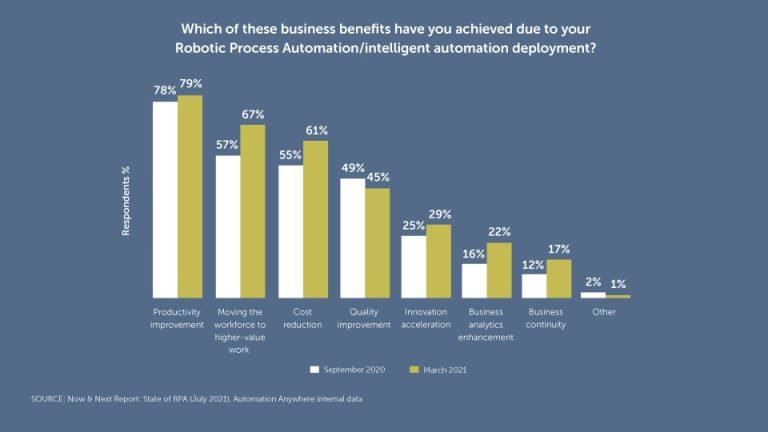How to More Accurately Calculate RPA ROI
RPA done correctly delivers ROI. High ROI. The average ROI achieved by businesses, according to Automation Anywhere’s most recent Now & Next report, is 250%, typically paid back within six to nine months after deployment. Top performers—those companies that followed industry best practices—received an average of 380% ROI on their RPA investments. These numbers speak to the business value of RPA technology.
But how do you measure ROI? There are many ROI calculators that attempt to walk you through a series of questions that supposedly will reveal break-even points and the total cost of ownership (TCO). But the fact remains that ROI for RPA is a nebulous thing, difficult to capture precisely. Attempting to apply a simple formula usually won’t work.
Difficult to apply
There is a simple ROI formula. It’s just difficult to apply it to RPA.
You calculate ROI by subtracting the initial value of your investment from the final value of the investment. This is called the net return. You then divide the net return by the cost of the investment and multiply by 100. Voila!
Let’s make it even simpler. Let’s say you take the total value you received from your investment in RPA and divide it by the total cost of implementing RPA.
You can probably see what the problem is. Measuring the costs can be complicated if you want to do it precisely, but it can be done. But the “total value” is not easy to calculate with RPA because it consists of both hard financial returns (good) and intangible, indirect returns (difficult to capture precisely).
Let’s consider costs and benefits metrics in turn.
Measuring the cost
This can be done because it consists of four basic, quantifiable things:
- The cost of the RPA solution (add up licensing, subscription, maintenance, etc.)
- The cost of extra infrastructure (the cost of the hardware, software, and networking infrastructure required to support the RPA solution)
- The cost of development (the cost of development tools plus the time of developers, business analysts, and users to analyze, redesign, and automate the process or processes in question)
- The cost of ongoing maintenance (add up the time of personnel needed to monitor and maintain the RPA software multiplied by their fully loaded cost to your business)
This takes attention to detail, but it has to be done.
Measuring the return
Measuring the return is more difficult because of the intangible benefits RPA offers.
Take the example of a hard financial return: By automating a business process, you saved the equivalent of one full-time employee’s (FTE’s) time for a year. You calculate the dollar value of that return by finding out the “fully loaded” annual cost of an FTE (fully loaded means including benefits, taxes, retirement plans, and all other costs). There you have it: $50,000. Or $100,000. Or whatever. That’s a nice hard number.
But here’s an example of an intangible return: Your employees are happier because they’ve gotten rid of drudge work and are free to do higher-value work. How do you measure happiness? And how do you assess the value of employee activities that are perhaps more strategic to the business? How do you measure the benefit of a better decision being made?
Measuring the most intangible benefits desired from RPA
Although reducing costs can be a driver for deploying RPA, today, most businesses are after the more difficult-to-measure benefits. In Automation Anywhere’s Now & Next report, productivity improvement was the No. 1 reported benefit, followed by moving employees to higher-value work. Cost reduction came in third, followed by quality improvements.

Here are the definitions of the most popular RPA benefits:
- Productivity: Can workers achieve more in the same amount of time?
- Quality: Are there fewer errors?
- Efficiency: Can tasks be completed faster (or perhaps eliminated)?
- Employee satisfaction: Are employees happier?
- Customer experience: Are customers getting a better experience?
- Business agility: Can the company adjust to changes in the market more quickly and effectively?
- Business continuity: Can the business keep operating no matter what happens?
So perhaps you can’t get a precise reading on the ROI of having more satisfied employees. But you can identify key performance indicators (KPIs) and use them as “proxies” or stand-ins.